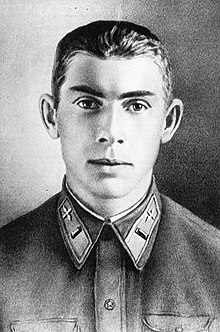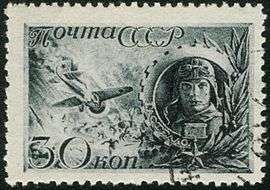Nikolai Gastello
Captain Nikolai Frantsevich Gastello (Russian: Николай Францевич Гастелло, April 23, 1907 – June 26, 1941) was a Russian aviator and a Hero of the Soviet Union. He is one of the best known Soviet war heroes, being the best known Soviet pilot to conduct a "fire taran" – a suicide action by the pilot of an aircraft on fire, flying into a target with the intention of setting it alight.
Nikolai Gastello | |
|---|---|
 | |
| Born | April 23 1907 Moscow, Russian Empire |
| Died | 26 June 1941 (aged 33) |
| Allegiance | |
| Service/ | |
| Years of service | 1932–1941 |
| Awards | Hero of the Soviet Union |
Biography
Nikolai Gastello was born in Moscow to Franz Gastello, who was a Belarusian. His father had recently moved to Moscow and changed his Belarusian last name Gastylo to an exotic-sounding Gastello.
Nikolay Gastello graduated from a Sokolniki high school in Moscow in 1918, and his family then moved to Bashkiria, escaping the horrors of the Russian Civil War. By 1923 Gastello was back in Moscow, where he worked at a factory as a fitter.[1] In 1928 he became a member of the communist party, and in 1932 by special decree he was sent to the Lugansk Pilot's School. Graduating in 1933 as a bomber pilot, Gastello initially flew the Tupolev TB-3 heavy bomber. Gastello fought against the Japanese in Battle of Khalkin Gol in 1939, where he was awarded the Order of Lenin; he then saw action in the Winter War with Finland.
By the time Germany attacked Soviet Union on June 22 of 1941, Gastello was a squadron leader in a long-range bomber regiment equipped with Ilyushin DB-3 medium bombers. On June 26, five days after the war started, a pair of aircraft led by Gastello bombed a German position near the village of Dekshany in Belarus. Gastello's bomber was reportedly hit by flak, with his wing fuel tank being ruptured and the aircraft subsequently becoming engulfed in flames. He then deliberately directed the doomed aircraft into a German Panzer column, performing the first "fire taran" of the German-Soviet War.
Gastello was posthumously awarded the Hero of the Soviet Union, one of the first Soviet soldiers to receive the title in World War II. Subsequently, he became one of the best-known heroes of the war, with his story and that of Zoya Kosmodemyanskaya taking up the bulk of Soviet text books on the early years of the German-Soviet War.
Official details of the final mission
In the first three days of the war, the commanders of the Soviet 3rd Air Corps still attempted to use their DB-3 bombers in their primary role, as a medium altitude level bomber, operating mainly at night. However the losses the Soviet aviation suffered were too heavy to allow such luxuries. By the 25th the 207th BAP (Bomber Aviation Regiment) of the 3rd DBAK (Long-Range Bomber Corps) was forced to launch small flights of unescorted DB-3s on low-level ground attack missions that these large lumbering aircraft were hardly suitable for. Having flown three conventional night-time bombing missions, Gastello was facing increasingly unfavorable odds. The day before his final sortie he returned to base with heavy battle damage, and his regular navigator badly wounded.
The next day, the 26th of June, Gastello's regiment, the 207th flew multiple sorties targeting enemy transport columns along the Molodechno–Radoshkovichi highway. Bombers were launched in pairs, without fighter escort, with about two-hour intervals between pairs. The day's first sortie took off at 0830, led by Captain Maslov. Senior Lt Viskovsky's pair took off at 1000. Captain Gastello's zveno (flight) of DB-3F's took off at 1200. Gastello's wingman was Lt. Vorobiev.
A total of four people were in Gastello's aircraft: Gastello himself, his navigator lieutenant Anatoly Burdenyuk, sergeant Aleksy Kalinin in the dorsal gunner turret, and lieutenant Grigory Skorobogaty in the ventral gunner position. Skorobogatov was the squadron adjutant, a staff officer, and gunner stations were usually manned by NCOs; however Skorobogatov decided to jump into Gastello's bomber at the last minute, for uncertain reasons.
The only surviving aircraft of Gastello's flight, Lt. Vorobiev's bomber, returned to base sometime after 2 pm. The only known crewmen of the second bomber are lieutenant Vorobiev and his navigator lieutenant Rybas. They reported that after about an hour in the air, they located a large armored column on the highway near the village of Dekshany, and conducted a bombing run from 400 meters of altitude. Having expended his bomb load, Gastello then flew a low-level pass, with his defensive gunners firing their 12.7mm (.50 cal) machine-guns at enemy vehicles. Gastello's plane received a direct hit in the fuel tank and caught fire. Initially set on a return course, his burning bomber then turned around, headed back to the transport column, and dove straight in, causing a "powerful explosion that shook the gaggle of enemy armored vehicles, and caused a burning storm that engulfed other enemy tanks".
The report of a large number of German tanks destroyed in the suicide attack apparently was deemed important enough to require independent proof. The next day regiment HQ ordered a reconnaissance flight to photograph the strike area. The photos it brought back reportedly showed a typical large crater, with burned-out German tanks surrounding it.
On July 6, 1941, a report of Gastello's mission was read all over the Soviet Union in the official daily radio news report. Soviet newspapers immediately took up the story, praising Gastello's heroism, but leaving most of the details very scarce. The accuracy of these early reports varies greatly, and even the date of Gastello's final mission is often incorrectly given as June 28 and sometimes even July 3.
On July 25, Gastello was posthumously awarded the Gold Star of the Hero of the Soviet Union. His other crew members received only minor medals.
Gastello's regiment meanwhile continued to suffer very heavy losses. In the first month of the war they lost 47 bombers with their crews. Out of 148 men lost, the details of only 12 are known; the rest are lost over enemy-held territory with no witnesses. Out of 27 planes sent to Radoshkovichi only one plane returned, that of Lt. Vorobiev. By September the regiment had lost all of its battle strength and existed only on paper. It was quietly disbanded.
Controversy

The details of Gastello's final mission are hard to substantiate due to lack of reliable data or witnesses. The only Soviet people alive to see Gastello's final plunge, the crew of Lt. Vorobiev, were killed in action just a few days after Gastello.
After the fall of the Soviet Union on December 25, 1991, several reporters began disputing the official accounts. Some of the claims made were:
- Gastello did not perform the attack deliberately.
- The target of the fire taran was not a column of tanks, but a stationary flak gun, apparently the one that dealt the burning aircraft the fatal blow.
- The suicide attack was performed by another pilot from the same squadron, Captain Maslov.
- Gastello's flight included not two, but three aircraft, with Maslov flying the third bomber.
- Gastello's plane was hit, but it flew away from the battle, with one crew member being seen to bail out.
- A man who was 15 years old in 1941 claimed he saw someone jump off the left wing of the aircraft, which would only be possible for the pilot to do. The bailed out airman, who he believed to be Gastello, was captured by the Germans.
- A burned out body was discovered in the woods in July 1941 by a group of peasants, far away from the location of the fire taran, with an undelivered letter and a cigarette case identifying it as a member of Gastello's crew.
- A 1951 Soviet reburial effort exhumed the graves of Gastello's crew, who were wrapped in parachutes and hastily buried by peasants the night after their death. A map case and a medallion belonged to Captain Maslov and his gunner were found on the bodies. The entire affair was subsequently swept under the rug.
- Neither Gastello nor Maslov managed to hit anything of value, and the actual fire taran was performed a day later, by Isaac Zilovich Presaizen, reported by Squadron Commander Captain Beletsky and verified from the air the next day by 128 Air Regiment Second in Command V. Sandalov. Isaac Presaizen was recommended for Hero of the Soviet Union award; the recommendation still stands in the archives, having never been answered. The actual air photos taken by V. Sandalov were used to award Gastello his fame for non-existent attack.[2]
These claims, made in 1994 and then in 2001 in Russia's leading newspapers, Izvestia and then Moskovskiy Komsomoletz, caused a firestorm in the former Soviet Union. They have been aggressively debunked by journalists and official historians ever since. The regiment's official logs, locked away in Soviet archives, indeed record Gastello's flight as only including two aircraft, his and Lt. Vorobiev's. Few reasons exist to doubt Lt. Vorobiev's actual report: he could gain nothing from it personally, and indeed perished in battle just a few days later. The official log, however, does list a single unidentified crew member as bailing out from Gastello's plane.
Supporters of the official version of events also doubt the accuracy of the 1951 reburial story, as an aircraft that dives into the ground and explodes in a fireball is unlikely to include entire bodies with intact parachutes they can be wrapped in. If such bodies were indeed located and buried, it is not surprising they would be from a crew other than Gastello's.
Both sides however agree that, whoever it was that exploded amidst German tanks on June 26, 1941, the pilot's motivation will never be truly known. No radio transmissions were received from the aircraft, as it was most unlikely that it had a radio, and it is impossible to know if the ramming of the German column was deliberate or accidental.
The publicity led to President Boris Yeltsin awarding Captain Maslov the Hero of Russia in 1996. On the other hand, First Lieutenant Isaac Presaizen was never awarded a Hero for the confirmed hit to this day.
See also
References
- "ВОЕННАЯ ЛИТЕРАТУРА --[ Мемуары ]-- Скрипко Н.С. По целям ближним и дальним". militera.lib.ru.
- "Первый огненный таран Великой Отечественной". evreimir.com.
External links
- Biography – in Russian
Sources
| Wikimedia Commons has media related to Nikolai Gastello. |
- Bio at airwar.ru (in Russian)
- Nikolai Gastello from the Legends and Facts series (in Russian)
- Legends of World War II (in Russian)
- Presaizen Isaac Zilovich at airwar.ru (in Russian)
- Word of the disabled veteran – Слово инвалида войны. №9, 1994, page 36. (Israel)